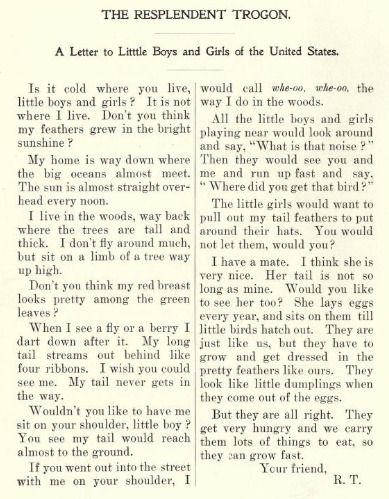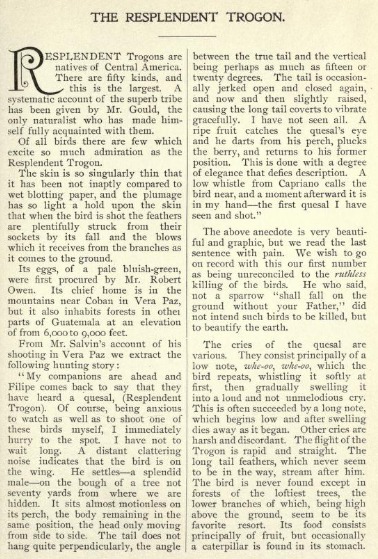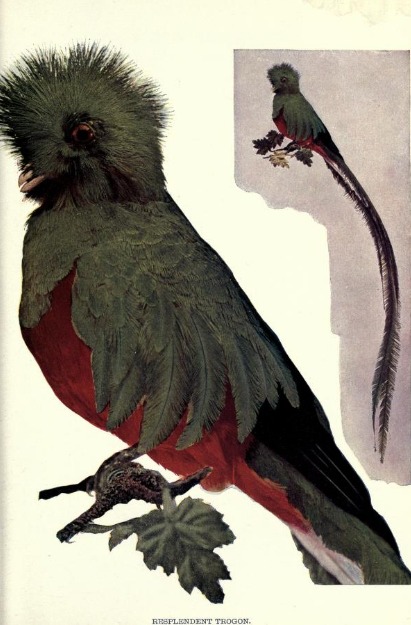The second bird in our birds of the January 1897 issue of Birds: A Monthly Serial is the Resplendent Trogon. Does the Resplendent Trogon shine brightly enough to stand with the previous bird, the Nonpareil? I think so. Is the Resplendent Trogon article content, written for kids, more amenable for small children today than the Nonpareil article? Well, that may be a different matter. But let us put the introduction aside and move on to the content.
You can find the original Resplendent Trogon content on Project Gutenberg and The Internet Archive.
The Resplendent Trogon, Illustrated
Below, you will find the Resplendent Trogon, as pictured in the magazine.

“Resplendent” seems like an apt adjective for such a magnificent bird. Note the illustration in the top right highlights its streaming tail. While the Nonpareil in the previous article came off as a bit cocky, you can see that the Resplendent Trogon here knows that he is transcendently resplendent.
For those of you who might be curious, “resplendent” means shining brightly.
Resplendent Trogon are most commonly known today as Resplendent Quetzals.
Mr. Resplendent Trogon’s Self-Introduction
Like the Nonpareil before him, the Resplendent Trogon speaks (or chirps) directly to young readers. How do I know that this Resplendent Trogon is a “he.” Well, he talks about his egg-laying mate. Inductive reasoning. I yield the floor to Mr. Resplendent Trogon himself.

Where Does Mr. Resplendent Trogon Live?
Mr. Respondent Trogon begins his piece by asking: “Is it cold where you live, little boys and girls?” It certainly is for much of The New Leaf Journal’s own audience, but he states asserts that it is not cold where he lives. “Don’t you think my feathers grew in the bright sunshine?” Sure enough, science suggests that a bird as resplendent as Mr. Trogon could only live in bright sun.
Mr. Respondent Trogon explains that his “home is way down where the big oceans almost meet.” As we will see, Mr. Resplendent Trogon accurately described his home in Southern Mexico and Central America.
Mr. Resplendent Trogon states that he makes his home “in the woods, way back where the trees are tall and thick.”
What Does Mr. Resplendent Trogon Eat?
Mr. Resplendent Trogon tells us that when he sees “a fly or berry,” he “dart[s] down after it.” In so doing, his “long tail streams out behind like four ribbons.” Mr. Resplendent Trogon wishes that we could see him dart, noting that his long streaming tail “never gets in the way.”
What About Mr. Resplendent Trogon’s Family?
Mr. Resplendent Trogon is a family man.
He describes his mate as “very nice,” but adds that her tail is not as long as his. He asks if we would like to see her too. I certainly would, but sadly the magazine does not offer a picture. Let down.
We learn that Ms. Resplendent Trogon lays eggs annually. She then sits on them “till little birds hatch out.” While Mr. Resplendent Trogon’s Mini Resplendent Trogons are just like him and their mother, he adds that “they have to grow and get dressed up in pretty flowers” to look just like their parents. Mr. Resplendent Trogon, clearly a proud father, states that the little Resplendent Trogons “look like little dumplings when they come out of the eggs.”
The little Resplendent Trogons apparently “get very hungry.” But fear not, Mr. Resplendent Trogon and his mate “carry them lots of things to eat, so they can grow fast.”
Do You Want a Resplendent Trogon?
You cannot have a Resplendent Trogon.
Unlike the pet Mr. Nonpareil from the previous issue, Mr. Resplendent Trogon lives high in the trees in Central America. Rather than talk about the birdcage life, he asked whether we think that his “red breast looks pretty among the green leaves.” Mr. Resplendent Trogon has a fine sense of aesthetics.
But suppose that you could have a pet Resplendent Trogon, would you not want Mr. Resplendent Trogon to sit on your shoulder? Speaking to a little boy, he notes that his tail would almost reach the ground were he to do so.
Mr. Resplendent Trogon said that if you reached the corner with him on his shoulder, he “would call whe-oo,” just like he does in the woods. “All the little boys and girls playing near would look around and say, ‘What is that noise?’” What would the boys and girls do next, Mr. Resplendent Trogon? “Then they would see you and me and run up fast and say, ‘Where did you get that bird?’” That is probably correct, actually. If I saw someone I knew with a Resplendent Trogon on his or her shoulder, I too would inquire as to where the person procured such a resplendent bird.
Resplendent Trogon Facts
After giving Mr. Resplendent Trogon the stage, the magazine offers facts about the magnificent avian from third-party experts. However, as we will see, these facts veer into questionable territory for articles aimed at introducing fantastic birds to young children.

Resplendent Trogon Habitats
While Mr. Resplendent Trogon offered a clue, the additional explanation expressly states that he is native to Central America. According to a the American Bird Conservatory, “[t]wo subspecies of Resplendent Quetzal are recognized, ranging from southern Mexico through Guatemala, Honduras, El Salvador, Nicaragua, and Costa Rica south to Western Panama.” The American Bird Conservatory adds that the Resplendent Trogons “inhabit undisturbed montain forests up to 10,500 feet in elevation.” The 1897 article notes that the Resplendent Trogon “inhabits forests in … parts of Guatemala at an elevation of 6,000 to 9,000 feet.”
The magazine that the Resplendent Trogon “is never found except in forests of the loftiest trees, the lower branches of which, being high above the ground, seem to be its favorite resort.”
Resplendent Trogon Diet
The magazine recounts that the Resplendent Trogon’s “food consists principally of fruit…” However, “occasionally a caterpillar is found in its stomach.”
The American Bird Conservatory seconds the Bird Magazine’s view, stating that “the Resplendent Quetzal is mainly fruit-eating,” and that it “favors fruits of the avocado family, which it swallows whole before regurgitating the pits.” Just as the Bird magazine, the American Bird Conservatory notes that the Resplendent Quetzal does not exclusively eat fruit: “its diet also includes insects, small frogs, snails, and lizards.”
Resplendent Trogon Eggs
The article tells us that Resplendent Trogon eggs are “pale bluish-green…”
Resplendent Trogon’s Thin Skin
While there is no evidence that the Resplendent Trogon is thin-skinned, it does apparently have thin skin. “The skin [of the Resplendent Trogon] is so singularly thin that it has been not inaptly compared to wet blotting paper…” We are told that the “plumage has … a [light] hold upon the skin.”
When the Resplendent Trogon Cries
The magazine describes the myriad cries of the Resplendent Trogan:
The cries of the quetzal are various. They consist principally of a low note, whe-oo, whe-oo, which the bird repeats, whistling it softly at first, then gradually swelling it into a loud and not unmelodious cry. This is often succeeded by a long note, which begins low and after swelling dies away as it began. Other cries are harsh and discordant.
Jan. 1897 Birds: A Monthly Serial on the cries of the Resplendent Trogon
The Resplendent Trogon is capable of soft cries and loud, cries that are “non unmelodious” and cries that are harsh. This passage is the most vivid description of an aspect of the Resplendent Trogan in the post. But listen for yourself! The American Bird Conservatory’s page on the Resplendent Quetzal includes a recording of the bird’s cry.
Why is there a Long Anecdote About Shooting the Resplendent Trogon?
For some reason that is beyond me, nearly half of the magazine’s section explaining the Resplendent Trogon was dedicated to an anecdote about hunting the Resplendent Trogon. Even before we reach the long anecdote, the article describes in detail what happens to a Resplendent Trogon’s feathers as it falls from the air after being shot.
The hunting anecdote itself is peculiar in context. The hunter begins by offering an eloquent description of the Resplendent Trogon. Then the hunter describes the moment he shoots the Resplendent Trogon. Bearing in mind that this magazine was to inspire a love of birds in children, what do we gain from the inclusion of the anecdote about hunting the Resplendent Trogon?
The magazine describes the anecdote as “very beautiful and graphic,” which is true to a point. The Birds magazine states that it read the end of the anecdote, which describes shooting the Resplendent Trogon, “with pain.” It added that it “wish[ed] to go on record with this our first number as being unreconciled to the ruthless killing of birds.” It could go without saying that the publishers of a magazine designed to “lead [children] to love the birds and delight in their story and acquaintance” would be “unreconciled to the ruthless killing of birds.”
I was curious whether the anecdote was included to highlight hunting as a major threat to the Resplendent Trogon. However, I found nothing suggesting that this was or is the case. Today, its conservation status is “Near Threatened,” but the American Bird Society cites “habitat loss” as the most pressing concern for the bird, with being hunted and captured for the pet trade as ancillary issues.
No matter how I slice it, this section seems out of place given the magazine’s statement of purpose.
A Resplendent Review and Conclusion
Before reading this article, I had never heard of the Resplendent Trogon. The content was quite informative, and the information about the Resplendent Trogon included in the article was nearly entirely in accord with information in contemporary sources, only lacking some slight degree of detail.

For the most part, the Resplendent Trogon passages would make for fine reading for kids today. It compares favorably to the Nonpareil chapter in terms of the information remaining true today. For younger readers, I would consider cutting the Resplendent Trogon hunting section, or cutting it to focus on the description of the bird. While perhaps fine nineteenth century hunting literature, it adds little to a curious child’s knowledge of avian life, especially in light of the fact that hunting does not seem to be a major Resplendent Trogon issue. In its entirety, however, the anecdote may foster nightmares about fallen Resplendent Trogons.
I enjoyed learning about the Resplendent Trogon and sharing this interesting content with you. There is no bird in the January issue of Birds: A Monthly Serial, cuts so striking a profile as the Resplendent Trogon.